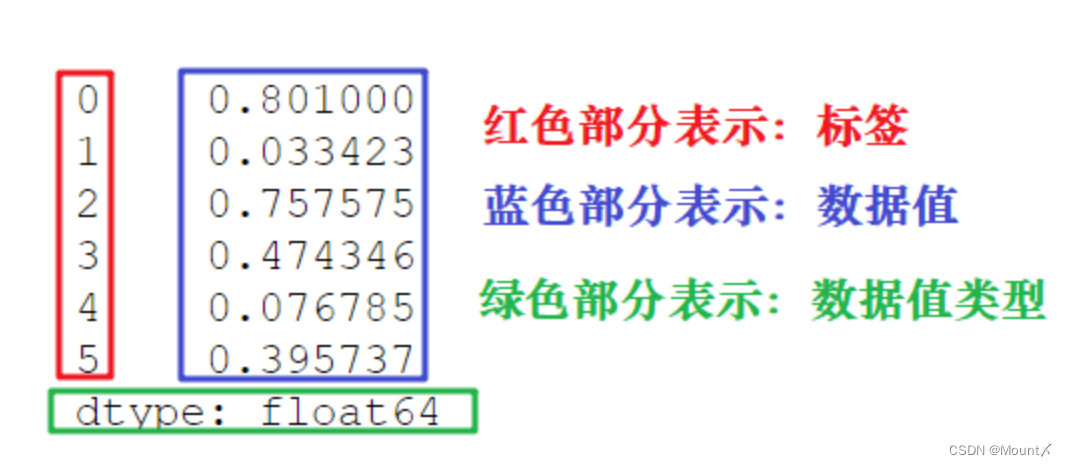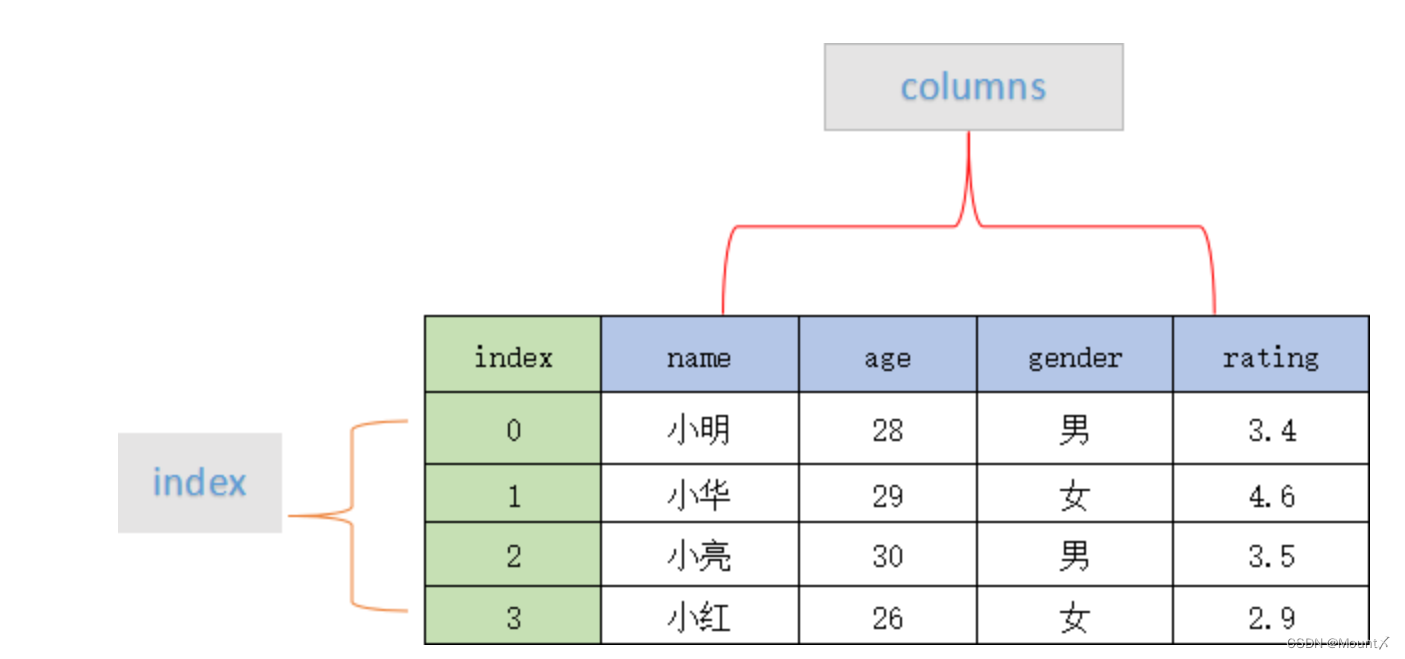目录
一、前言
本文不会详细介绍pandas各种优势、特点、用途这些无关紧要的东西,主要围绕Series和DataFrame这两种数据结构的用法来进行讲解,旨在帮助读者花最少的时间了解pandas该怎么用,适合了解但不熟练的同学用来加强巩固和复习。也相当于作者自己的一篇复习笔记,主要参考该网址内容:Pandas Series入门教程
下面开始正文部分
二、Pandas内置数据结构
pandas主要有两种内置数据结构:Series和DataFrame
2-1.Series结构:
它是一种类似于一维数组的结构,由一组数据值和标签组成,其中标签与数据值之间是一一对应的关系,类似于python的字典,可以参考下图理解。

2-2.DataFrame结构
它是一个表格型的数据结构,既有行标签,又有列标签,类似于excel。其结构图示意图,如下所示:

三、使用方法
3-1.Series的使用
3-1-1.创建Series对象:
pandas 使用 Series() 函数来创建 Series 对象,通过这个对象可以调用相应的方法和属性,从而达到处理数据的目的:
s=pd.Series( data, index, dtype, copy)
参数说明如下所示:
| 参数名称 | 描述 |
|---|---|
| data | 输入的数据,可以是列表、常量、ndarray 数组等。 |
| index | 索引值必须是惟一的,如果没有传递索引,则默认为 np.arrange(n)。 |
| dtype | dtype表示数据类型,如果没有提供,则会自动判断得出。 |
| copy | 表示对 data 进行拷贝,默认为 False。 |
1) 列表创建Series对象
import pandas as pd
s = pd.Series([1, 'a', '你好'])
print(s)
输出结果如下:
0 1
1 a
2 你好
dtype: object
2) ndarray创建Series对象
使用默认索引,创建 Series 序列对象:
import pandas as pd
import numpy as np
data = np.array(['a','b','c','d'])
s = pd.Series(data)
print (s)输出结果如下:
0 a 1 b 2 c 3 d dtype: object
上述示例中没有传递任何索引,所以索引默认从 0 开始分配 ,其索引范围为 0 到len(data)-1,即 0 到 3。这种设置方式被称为“隐式索引”。
除了上述方法外,你也可以使用“显式索引”的方法定义索引标签,示例如下:
import pandas as pd
import numpy as np
data = np.array(['a','b','c','d'])
#自定义索引标签(即显示索引)
s = pd.Series(data,index=[100,101,102,103])
print(s)输出结果:
100 a 101 b 102 c 103 d dtype: object
3) dict创建Series对象
import pandas as pd
import numpy as np
data = {'a' : 0., 'b' : 1., 'c' : 2.}
s = pd.Series(data)
print(s)输出结果:
a 0.0 b 1.0 c 2.0 dtype: float64
4) 标量创建Series对象
如果 data 是标量值,则必须提供索引,示例如下:
import pandas as pd
import numpy as np
s = pd.Series(5, index=[0, 1, 2, 3])
print(s)输出如下:
0 5 1 5 2 5 3 5 dtype: int64
标量值按照 index 的数量进行重复,并与其一一对应。
3-1-2访问Series数据
分为两种方式,一种是位置索引访问,另一种是索引标签访问。
1) 位置索引访问
这种访问方式和操作列表相似,使用元素自身的下标进行访问,而且支持切片
示例1,使用下标访问单个元素值:
import pandas as pd
s = pd.Series([-6, 6, 6.66, 'a', '你好'])
print(s[0])
输出结果
6
示例 2,使用切片访问 多个元素值
import pandas as pd
s = pd.Series([-6, 6, 6.66, 'a', '你好'])
print(s[2:5])
输出结果
2 6.66
3 a
4 你好
dtype: object
2) 索引标签访问
这种访问方法类似于python的字典
示例1,使用索标签访问单个元素值:
import pandas as pd
s = pd.Series([-6, 6, 6.66, 'a', '你好'], index=['a', 'b', 'c', 'd', 'e'])
print(s['e'])
输出结果
你好
示例 2,使用索引标签访问多个元素值
import pandas as pd
s = pd.Series([-6, 6, 6.66, 'a', '你好'], index=['a', 'b', 'c', 'd', 'e'])
print(s[['a', 'c', 'b']])
import pandas as pd s = pd.Series([-6, 6, 6.66, 'a', '你好'], index=['a', 'b', 'c', 'd', 'e']) print(s[['a', 'c', 'b']])
3-1-3.Series常用属性
下面我们介绍 Series 的常用属性和方法。在下表列出了 Series 对象的常用属性。
| 名称 | 属性 |
|---|---|
| axes | 以列表的形式返回所有行索引标签。 |
| dtype | 返回对象的数据类型。 |
| empty | 返回一个空的 Series 对象。 |
| ndim | 返回输入数据的维数。 |
| size | 返回输入数据的元素数量。 |
| values | 以 ndarray 的形式返回 Series 对象。 |
| index | 返回一个RangeIndex对象,用来描述索引的取值范围。 |
import pandas as pd
s = pd.Series([-6, 6, 6.66, 'a', '你好'], index=['a', 'b', 'c', 'd', 'e'])
print(s.axes)
print(s.dtype)
print(s.empty)
print(s.ndim)
print(s.size)
print(s.values)
print(s.index)输出结果
[Index(['a', 'b', 'c', 'd', 'e'], dtype='object')]
object
False
1
5
[-6 6 6.66 'a' '你好']
Index(['a', 'b', 'c', 'd', 'e'], dtype='object')
3-1-4:Series常用方法
1) head()&tail()查看数据
如果想要查看 Series 的某一部分数据,可以使用 head(n) 或者 tail(n) 方法。其中 head() 返回前 n 行数据,默认显示前 5 行数据。示例如下:
import pandas as pd
import numpy as np
s = pd.Series(np.random.randn(5))
print ("The original series is:")
print (s)
#返回前三行数据
print (s.head(3))输出结果:
原系列输出结果: 0 1.249679 1 0.636487 2 -0.987621 3 0.999613 4 1.607751 head(3)输出: dtype: float64 0 1.249679 1 0.636487 2 -0.987621 dtype: float64
tail() 返回的是后 n 行数据,默认为后 5 行。示例如下:
import pandas as pd
import numpy as np
s = pd.Series(np.random.randn(4))
#原series
print(s)
#输出后两行数据
print (s.tail(2))输出结果:
原Series输出: 0 0.053340 1 2.165836 2 -0.719175 3 -0.035178 输出后两行数据: dtype: float64 2 -0.719175 3 -0.035178 dtype: float64
2) isnull()&nonull()检测缺失值
isnull() 和 nonull() 用于检测 Series 中的缺失值。所谓缺失值,顾名思义就是值不存在、丢失、缺少。
- isnull():如果为值不存在或者缺失,则返回 True。
- notnull():如果值不存在或者缺失,则返回 False。
import pandas as pd
#None代表缺失数据
s=pd.Series([1,2,5,None])
print(pd.isnull(s)) #是空值返回True
print(pd.notnull(s)) #空值返回False输出结果:
0 False 1 False 2 False 3 True dtype: bool notnull(): 0 True 1 True 2 True 3 False dtype: bool
3-2.DataFrame的使用
3-2-1.创建 DataFrame 对象
import pandas as pd
pd.DataFrame( data, index, columns, dtype, copy)参数说明:
| 参数名称 | 说明 |
|---|---|
| data | 输入的数据,可以是 ndarray,series,list,dict,标量以及一个 DataFrame。 |
| index | 行标签,如果没有传递 index 值,则默认行标签是 np.arange(n),n 代表 data 的元素个数。 |
| columns | 列标签,如果没有传递 columns 值,则默认列标签是 np.arange(n)。 |
| dtype | dtype表示每一列的数据类型。 |
| copy | 默认为 False,表示复制数据 data。 |
1) 列表创建DataFame对象
import pandas as pd
data = [['Alex',10],['Bob',12],['Clarke',13]]
df = pd.DataFrame(data,columns=['Name','Age'])
print(df)输出结果:
Name Age 0 Alex 10 1 Bob 12 2 Clarke 13
2) 字典嵌套列表创建
无自定义标签
import pandas as pd
data = {'Name':['Tom', 'Jack', 'Steve', 'Ricky'],'Age':[28,34,29,42]}
df = pd.DataFrame(data)
print(df)输出结果:
Age Name 0 28 Tom 1 34 Jack 2 29 Steve 3 42 Ricky
有自定义标签:
import pandas as pd
data = {'Name':['Tom', 'Jack', 'Steve', 'Ricky'],'Age':[28,34,29,42]}
df = pd.DataFrame(data, index=['rank1','rank2','rank3','rank4'])
print(df)输出结果如下:
Age Name rank1 28 Tom rank2 34 Jack rank3 29 Steve rank4 42 Ricky
3) 列表嵌套字典创建DataFrame对象
import pandas as pd
data = [{'a': 1, 'b': 2},{'a': 5, 'b': 10, 'c': 20}]
df = pd.DataFrame(data, index=['first', 'second'])
print(df)输出结果:
a b c first 1 2 NaN second 5 10 20.0
import pandas as pd
data = [{'a': 1, 'b': 2},{'a': 5, 'b': 10, 'c': 20}]
df1 = pd.DataFrame(data, index=['first', 'second'], columns=['a', 'b'])
df2 = pd.DataFrame(data, index=['first', 'second'], columns=['a', 'b1'])
print(df1)
print(df2)输出结果:
#df2输出
a b
first 1 2
second 5 10
#df1输出
a b1
first 1 NaN
second 5 NaN
注意:因为 b1 在字典键中不存在,所以对应值为 NaN。
4) Series创建DataFrame对象
import pandas as pd
d = {'one' : pd.Series([1, 2, 3], index=['a', 'b', 'c']),
'two' : pd.Series([1, 2, 3, 4], index=['a', 'b', 'c', 'd'])}
df = pd.DataFrame(d)
print(df)输出结果如下:
one two a 1.0 1 b 2.0 2 c 3.0 3 d NaN 4
注意:对于 one 列而言,此处虽然显示了行索引 'd',但由于没有与其对应的值,所以它的值为 NaN。
3-2-2.操作DataFrame
3-2-2-1.列索引操作DataFrame
1) 列索引选取数据列
import pandas as pd
d = {'one' : pd.Series([1, 2, 3], index=['a', 'b', 'c']),
'two' : pd.Series([1, 2, 3, 4], index=['a', 'b', 'c', 'd'])}
df = pd.DataFrame(d)
print(df ['one'])输出结果:
a 1.0 b 2.0 c 3.0 d NaN Name: one, dtype: float64
2) 列索引添加数据列
使用 columns 列索引表标签可以实现添加新的数据列,示例如下:
import pandas as pd
d = {'one' : pd.Series([1, 2, 3], index=['a', 'b', 'c']),
'two' : pd.Series([1, 2, 3, 4], index=['a', 'b', 'c', 'd'])}
df = pd.DataFrame(d)
#使用df['列']=值,插入新的数据列
df['three']=pd.Series([10,20,30],index=['a','b','c'])
print(df)
#将已经存在的数据列做相加运算
df['four']=df['one']+df['three']
print(df)输出结果:
使用列索引创建新数据列:
one two three
a 1.0 1 10.0
b 2.0 2 20.0
c 3.0 3 30.0
d NaN 4 NaN
已存在的数据列做算术运算:
one two three four
a 1.0 1 10.0 11.0
b 2.0 2 20.0 22.0
c 3.0 3 30.0 33.0
d NaN 4 NaN NaN
还可以使用 insert() 方法插入新的列,示例如下:
import pandas as pd
info=[['Jack',18],['Helen',19],['John',17]]
df=pd.DataFrame(info,columns=['name','age'])
print(df)
#注意是column参数
#数值1代表插入到columns列表的索引位置
df.insert(1,column='score',value=[91,90,75])
print(df)输出结果:
添加前:
name age
0 Jack 18
1 Helen 19
2 John 17
添加后:
name score age
0 Jack 91 18
1 Helen 90 19
2 John 75 17
3) 列索引删除数据列
通过 del 和 pop() 都能够删除 DataFrame 中的数据列。示例如下:
import pandas as pd
d = {'one' : pd.Series([1, 2, 3], index=['a', 'b', 'c']),
'two' : pd.Series([1, 2, 3, 4], index=['a', 'b', 'c', 'd']),
'three' : pd.Series([10,20,30], index=['a','b','c'])}
df = pd.DataFrame(d)
print ("Our dataframe is:")
print(df)
#使用del删除
del df['one']
print(df)
#使用pop方法删除
df.pop('two')
print (df)输出结果:
原DataFrame:
one three two
a 1.0 10.0 1
b 2.0 20.0 2
c 3.0 30.0 3
d NaN NaN 4
使用del删除 first:
three two
a 10.0 1
b 20.0 2
c 30.0 3
d NaN 4
使用 pop()删除:
three
a 10.0
b 20.0
c 30.0
d NaN
3-2-2-2.行索引操作DataFrame
1) 标签索引选取
可以将行标签传递给 loc 函数,来选取数据。示例如下:
import pandas as pd
d = {'one' : pd.Series([1, 2, 3], index=['a', 'b', 'c']),
'two' : pd.Series([1, 2, 3, 4], index=['a', 'b', 'c', 'd'])}
df = pd.DataFrame(d)
print(df.loc['b'])输出结果:
one 2.0
two 2.0
Name: b, dtype: float64
2) 整数索引选取
通过将数据行所在的索引位置传递给 iloc 函数,也可以实现数据行选取。示例如下:
import pandas as pd
d = {'one' : pd.Series([1, 2, 3], index=['a', 'b', 'c']),
'two' : pd.Series([1, 2, 3, 4], index=['a', 'b', 'c', 'd'])}
df = pd.DataFrame(d)
print (df.iloc[2])输出结果:
one 3.0
two 3.0
Name: c, dtype: float64
3) 切片操作多行选取
您也可以使用切片的方式同时选取多行。示例如下:
import pandas as pd
d = {'one' : pd.Series([1, 2, 3], index=['a', 'b', 'c']),
'two' : pd.Series([1, 2, 3, 4], index=['a', 'b', 'c', 'd'])}
df = pd.DataFrame(d)
#左闭右开
print(df[2:4])输出结果:
one two
c 3.0 3
d NaN 4
4) 添加数据行
使用 _append() 函数,可以将新的数据行添加到 DataFrame 中,该函数会在行末追加数据行。
注意:append前面有一个下划线。
示例如下:
import pandas as pd
df = pd.DataFrame([[1, 2], [3, 4]], columns = ['a','b'])
df2 = pd.DataFrame([[5, 6], [7, 8]], columns = ['a','b'])
#在行末追加新数据行
df = df._append(df2)
print(df)运行结果:
a b
0 1 2
1 3 4
0 5 6
1 7 8
5) 删除数据行
您可以使用行索引标签,从 DataFrame 中删除某一行数据。如果索引标签存在重复,那么它们将被一起删除。示例如下:
import pandas as pd
df = pd.DataFrame([[1, 2], [3, 4]], columns = ['a','b'])
df2 = pd.DataFrame([[5, 6], [7, 8]], columns = ['a','b'])
df = df.append(df2)
print(df)
#注意此处调用了drop()方法
df = df.drop(0)
print (df)输出结果:
a b
1 3 4
1 7 8
在上述的示例中,默认使用 range(2) 生成了行索引,并通过 drop(0) 同时删除了两行数据。
3-2-3.常用属性和方法汇总
| 名称 | 属性&方法描述 |
|---|---|
| T | 行和列转置。 |
| axes | 返回一个仅以行轴标签和列轴标签为成员的列表。 |
| dtypes | 返回每列数据的数据类型。 |
| empty | DataFrame中没有数据或者任意坐标轴的长度为0,则返回True。 |
| ndim | 轴的数量,也指数组的维数。 |
| shape | 返回一个元组,表示了 DataFrame 维度。 |
| size | DataFrame中的元素数量。 |
| values | 使用 numpy 数组表示 DataFrame 中的元素值。 |
| head() | 返回前 n 行数据。 |
| tail() | 返回后 n 行数据。 |
| shift() | 将行或列移动指定的步幅长度 |





















 1307
1307











 被折叠的 条评论
为什么被折叠?
被折叠的 条评论
为什么被折叠?








